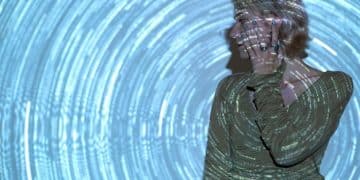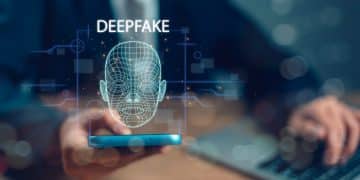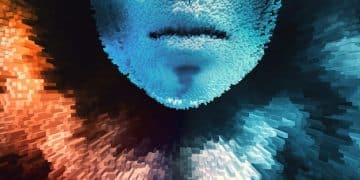Decoding Deepfakes: Identifying Manipulated Videos in Online News

Anúncios
The proliferation of deepfakes poses a significant challenge to media literacy and trust in online news, necessitating a clear understanding of practical methods for identifying these manipulated video contents to preserve informational integrity.
Anúncios
In an increasingly digital landscape, the line between reality and fabrication has become astonishingly blurred, particularly with the rise of AI-driven manipulation.
Understanding decoding deepfakes:
how to identify manipulated video content in online news is not just a technical skill but a crucial aspect of modern media literacy, essential for navigating the complex web of information and disinformation in our daily feeds.
Anúncios
The Deepfake Phenomenon: A Threat to Truth
The rapid evolution of artificial intelligence has introduced a powerful, yet concerning, technology: deepfakes.
These synthetic media, particularly video content, are generated using sophisticated AI algorithms, making it incredibly difficult to distinguish genuine footage from highly convincing fakes.
Their proliferation in online news presents a formidable challenge to journalistic integrity and public trust.
The ability of deepfakes to convincingly mimic real individuals performing actions or saying things they never did has profound implications.
Imagine a politician making a scandalous statement they never uttered, or a public figure appearing in a compromising situation that is entirely fabricated.
Such content, if widely disseminated and believed, can sway public opinion, incite unrest, or even undermine democratic processes.
The digital age has always contended with misinformation, but deepfakes elevate this threat to an unprecedented level, demanding a proactive and informed response from media consumers and creators alike.
The Mechanics of Deepfakes
Deepfakes are primarily created using a form of artificial intelligence called Generative Adversarial Networks (GANs). These networks consist of two main components: a generator and a discriminator.
The generator creates new data, in this case, a fake image or video. The discriminator then evaluates this fake data alongside real data, trying to determine which is which.
This adversarial process forces the generator to continuously improve its output until the discriminator can no longer reliably tell the difference.
This endless cycle of creation and detection allows deepfakes to become increasingly realistic, often surpassing the average human’s ability to discern their authenticity.
Beyond GANs, other machine learning techniques, like autoencoders, are also employed, but the core principle remains the same: synthesizing believable human speech, facial expressions, and body movements from existing data.
The more data available, the more convincing the deepfake.
Impact on Online News and Public Trust
The most troubling aspect of deepfakes is their potential to weaponize disinformation. In the context of online news, deepfakes can be used to:
- Fabricate events or statements to discredit political opponents.
- Manipulate financial markets with false announcements.
- Create revenge porn or exploit individuals for malicious purposes.
The speed at which news travels online means a deepfake can go viral before proper verification processes can catch up, leading to widespread belief in false narratives.
This erodes public trust not only in specific news outlets but in the very concept of objective reality, making it harder for individuals to make informed decisions based on credible information.
The ubiquity of social media platforms further exacerbates this issue. These platforms, designed for rapid content sharing, can inadvertently act as super-spreaders of deepfakes, reaching millions before they are identified and removed.
This necessitates a layered approach to media consumption, one that embraces a healthy skepticism and leverages tools and knowledge for verification.
Early Warning Signs: Visual and Audio Anomalies
Identifying deepfakes often comes down to meticulously observing subtle inconsistencies that human eyes and ears might initially overlook.
While AI constantly improves, it still struggles with replicating certain complex human characteristics and physical phenomena with perfect fidelity.
These imperfections serve as crucial early warning signs for discerning manipulated video content. Becoming adept at spotting these anomalies is a vital first line of defense in the battle against media deception.
It requires a keen eye and an understanding of what to look for, transforming casual viewing into an active process of information assessment.
Inconsistencies in Facial Features and Expressions
Deepfake technology excels at swapping faces or altering expressions, but often leaves subtle clues behind. One common tell is unusual eye behavior.
Eyes might appear overly static, lack natural blinking patterns, or exhibit strange reflections.
The gaze might not align naturally with the head’s movement, or the pupils might not react realistically to changes in lighting. Another red flag concerns facial symmetry and proportions.
Deepfakes can sometimes distort or subtly misalign features, making a face appear just “off.” The skin texture might seem unnaturally smooth or overly grainy, lacking the subtle imperfections and variations of real human skin.
Mouth and lip synchronization are frequent points of failure. The movement of lips might not perfectly match the spoken words, or the mouth shape could appear rubbery or stiff.
Even if the syncing is good, the surrounding facial musculature might not react as expected, leading to a disconnect between the sound and the visual.
Furthermore, deepfakes often struggle with realistic emotional expressions; a smile might not reach the eyes, or a frown could look unnaturally severe, betraying a lack of genuine underlying emotion.
Unnatural Body Movements and Interactions with Environment
Beyond the face, deepfakes frequently falter when attempting to replicate natural body movements and how a person interacts with their environment.
The shoulders, neck, or head might appear to be detached from the body, or move in an oddly jerky or robotic fashion. Hand gestures, so integral to human communication, can look stiff or repetitive, or even pass through objects unrealistically.
Lighting and shadows are also significant indicators; a deepfake might have inconsistencies in how light falls on the subject compared to the background, creating unnatural highlights or shadows.
The person might appear to be “floating” above the ground or seem unnaturally inserted into the scene, indicative of poor integration with the background.
Background elements can also offer clues. If the background appears static or unnaturally blurred while the foreground subject is sharp, it could be a sign of manipulation.
Similarly, inconsistencies in clothing, jewelry, or other personal items that are not seamlessly integrated can indicate a fabrication.
These environmental and physical discrepancies serve as strong signals that the video content has been tampered with, urging viewers to exercise caution and seek further verification before accepting the presented narrative as truth.
The Audio Landscape: Listening for Deception
While visual cues are often the first line of defense against deepfakes, the audio component can be equally, if not more, revealing. Manipulated audio, whether a deepfake voice or altered speech, presents its own set of challenges and unique tells.
A trained ear can detect subtle anomalies that betray synthetic creation, from unnatural inflections to environmental inconsistencies.
Paying close attention to the auditory landscape of a video is a critical step in a comprehensive deepfake detection strategy, reminding us that deceptive media appeals to more than just our eyes.

Voice Manipulation: Pitch, Accent, and Emotion Anomalies
Deepfake audio, particularly voice cloning, has become incredibly advanced, but it often struggles with the nuanced complexities of human speech. One common indicator is an unnatural or inconsistent pitch.
A voice might fluctuate erratically, or maintain an eerily flat tone that lacks the natural variations of human emotion. Accents can also be a giveaway; if a speaker’s accent suddenly shifts or sounds subtly off, it could indicate manipulation.
Perhaps the most challenging aspect for deepfake audio is replicating genuine emotion.
While the words might be accurate, the emotional resonance—the subtle changes in timbre, rhythm, and intensity that convey joy, anger, or sadness—is often missing or feels artificial.
The voice might sound too perfect, too smooth, lacking natural pauses, stutters, or breaths that characterize human speech.
Conversely, it might contain overly exaggerated or misplaced emotional cues that don’t align with the visual context. These subtle emotional disconnects are strong indicators of synthesized voices.
Background Noise and Room Acoustics Discrepancies
Authentic video content seamlessly integrates the speaker’s voice with the ambient sounds of the environment. Deepfake audio frequently fails to replicate this harmony.
If a person is purportedly speaking in a bustling street, but their voice sounds as though it was recorded in a soundproof studio, this discrepancy is a significant red flag.
Similarly, if the room acoustics—the way sound reflects off surfaces—do not match the visual setting, it suggests audio tampering.
For instance, a voice recorded in a large, empty hall should have a distinct echo, which deepfake audio might omit or mishandle.
The presence or absence of natural background noise is another critical clue.
A deepfake might have pristine audio that sounds too clean, devoid of the subtle hums, distant conversations, or ordinary environmental sounds that would typically accompany a given scene.
Conversely, it might contain superimposed background noise that loops unnaturally or does not react logically to visual events within the video.
These auditory mismatches, where what you hear doesn’t reconcile with what you see, should prompt immediate suspicion regarding the video’s authenticity.
Contextual Cues and Source Verification
Beyond the technical anomalies within the deepfake itself, a more holistic approach to identification involves rigorously examining contextual cues and verifying the source from which the content originates.
Even the most sophisticated deepfake can be exposed if its surrounding circumstances or provenance reveal inconsistencies.
This method moves beyond visual and audio scrutiny, emphasizing critical thinking about the narrative, the messenger, and the broader media landscape.
It underscores the importance of media literacy, urging viewers to ask not only “what am I seeing?” but also “where is this coming from, and why?”
Unusual Publication Patterns and Lack of Corroboration
One of the clearest contextual red flags is an unusual or inconsistent publication pattern.
If a sensational video appears out of nowhere, seemingly from an unknown or untraceable source, it warrants immediate suspicion.
Legitimate news organizations typically have established channels for distributing content, identifiable branding, and a track record of reporting.
Deepfakes, on the other hand, often emerge from obscure accounts, unverified social media profiles, or websites with questionable credibility, aiming for rapid, unchecked dissemination.
A sudden surge in sharing of a particular video, especially from accounts with low follower counts but high engagement rates, can also suggest a coordinated disinformation campaign.
Perhaps the most critical contextual cue is the lack of corroboration from reputable, independent news sources.
When a significant event or statement is reported, particularly one involving public figures or major societal implications, multiple credible outlets will typically cover it.
If a video presents groundbreaking or controversial content, yet no major news organizations or trusted journalists are reporting on it, this absence of corroboration is a strong indicator of potential fabrication.
Always cross-reference sensational claims with established media entities before accepting them as truth. The collective silence of reputable sources is often louder than the loudest deepfake.
Analyzing the Source and its History
Verifying the source of any online content is paramount, especially for videos. Begin by examining the originating platform or account. Is it an official news outlet, a verified public figure, or a known credible organization? Look for small details:
- Account creation date: Newly created accounts promoting highly controversial content are often suspicious.
- Previous posts: Does the account have a history of sharing unverified information?
- Engagement metrics: Are comments organic, or do they appear to be bot-generated or a coordinated attack?
If the source claims to be a well-known entity but uses a slightly different URL, a misspelled name, or a non-standard handle, it’s likely an impostor. Phishing and spoofing attempts often precede the dissemination of malicious deepfakes. Investigate the source’s reputation for accuracy, impartiality, and journalistic standards. A history of sensationalism, bias, or past instances of spreading false information should serve as a major warning sign. Always prioritize content from sources with a proven commitment to factual reporting and transparency.
Tools and Technologies for Deepfake Detection
While human vigilance and critical thinking are indispensable, the fight against deepfakes is increasingly augmented by sophisticated technological tools. As deepfake creation becomes more advanced, so too does deepfake detection.
A range of software and AI-powered platforms are being developed to assist in identifying manipulated video content, offering a more analytical and often faster approach than manual inspection alone.
These tools leverage computational power to spot anomalies that are invisible to the naked eye, providing an essential layer of verification in the complex landscape of online news.

AI-Powered Detection Platforms and Software
The most promising advancements in deepfake detection come from artificial intelligence itself.
Many tools use machine learning algorithms, trained on vast datasets of both real and synthetic media, to identify patterns indicative of manipulation.
These platforms can analyze video frames for subtle inconsistencies in pixelation, lighting, facial geometry, and motion that are beyond human perception.
For instance, some AI detectors focus on unique “fingerprints” left by specific deepfake algorithms or on the absence of natural physiological signals, like subtle changes in blood flow under the skin (photoplethysmography), which are difficult for AI to replicate accurately.
Several companies and research institutions are developing and deploying such technologies. Platforms like Sensity, DeepMotion, and Amped Software offer solutions for professional forensics and media organizations.
While not always publicly accessible in their full capacity, awareness of their existence highlights the arms race between deepfake creators and detectors.
These tools can often provide a confidence score regarding a video’s authenticity, guiding human analysts to areas that require further scrutiny.
As AI detection refines, it promises to become an increasingly vital part of the media ecosystem’s defense mechanisms.
Forensic Analysis Techniques
Beyond general AI detection, forensic video analysis involves detailed, often manual, investigation by experts using specialized software.
These techniques delve into the very fabric of the video file, examining metadata, compression artifacts, and digital signatures.
Every video recording device leaves a unique “signature” in the captured footage, related to its sensor, lens, and compression algorithms.
Forensic analysts can sometimes identify inconsistencies in these signatures, indicating that parts of the video were inserted or altered from a different source.
Detailed frame-by-frame analysis can reveal anomalies in pixel consistency, digital noise patterns, or subtle glitches that betray digital alteration.
Furthermore, tools can apply mathematical models to analyze discrepancies in lighting angles, shadow projections, and the physical properties of objects within the scene, detecting instances where elements appear to defy real-world physics.
While time-consuming and requiring specialized expertise, forensic analysis remains the gold standard for definitive verification, often used in legal contexts or high-stakes investigations where absolute certainty is required.
It’s the ultimate deep-dive into the digital footprint of disinformation.
The Human Element: Critical Thinking and Media Literacy
While technology offers powerful tools for detection, the most formidable defense against deepfakes remains the cultivated discerning mind of the individual.
No algorithm can wholly replace the critical thinking skills, healthy skepticism, and media literacy necessary to navigate a landscape increasingly saturated with sophisticated misinformation.
Recognizing and internalizing these human elements empowers individuals to become active participants in verifying information, rather than passive recipients. It underscores that technology is a tool, but judgment is inherent to human intelligence.
Developing a Skeptical Mindset
In an era of rapid information dissemination, cultivating a skeptical mindset is not about being cynical, but about being judicious.
It means approaching all online news content, especially sensational or emotionally charged material, with an initial question: “Is this real?” This involves:
- Questioning headlines: Are they overly dramatic or vague?
- Considering the source: Is it known for accuracy?
- Recognizing emotional manipulation: Is the content designed to evoke a strong, unthinking reaction?
A skeptical mindset encourages viewers to pause before sharing, to seek out additional information, and to avoid falling prey to confirmation bias—the tendency to believe information that aligns with existing beliefs, regardless of its veracity.
It’s an ongoing exercise in intellectual discipline, ensuring that initial gut reactions are superseded by reasoned inquiry. This habit of doubt is the critical first step in uncovering deception.
The Importance of Media Literacy Education
Media literacy involves understanding how media messages are constructed, for what purposes, and with what effects. In the context of deepfakes, media literacy education equips individuals with the knowledge and skills to:
- Identify common deepfake characteristics and techniques.
- Understand the motivations behind creating and spreading deepfakes.
- Utilize critical thinking strategies for evaluating digital content.
Educational initiatives can teach people to recognize visual anomalies, listen for audio inconsistencies, cross-reference information across multiple reliable sources, and understand the role of social media algorithms in content amplification.
These programs can range from school curricula to public awareness campaigns, providing practical tips and fostering an environment where discerning truth from falsehood becomes a societal norm.
Investing in media literacy is an investment in an informed citizenry, capable of resisting the insidious threat propagated by manipulated media.
Combating Deepfakes: Collaborative Solutions
The proliferation of deepfakes is not a problem that any single entity—whether a tech company, a government, or an individual—can solve in isolation. It demands a multifaceted, collaborative approach involving various stakeholders.
Effective solutions require innovative technological development, robust policy frameworks, and a commitment to transparency and public education.
The challenge of deepfakes necessitates an ecosystem of defense, where each component plays a vital role in curbing their spread and mitigating their impact on online news and public trust.
Role of Social Media Platforms and News Organizations
Social media platforms bear a significant responsibility in combating the spread of deepfakes due to their role as primary disseminators of online news.
They must invest in more sophisticated AI detection tools, streamline reporting mechanisms for manipulated content, and implement faster content removal policies.
Transparency is key: platforms should clearly label deepfake content when identified, providing context and warnings to users.
Collaboration with fact-checking organizations is crucial, allowing for rapid verification and debunking of false narratives before they gain widespread traction.
News organizations, on the other hand, must adopt rigorous verification protocols for video content, especially for user-generated or unverified sources.
They should prioritize ethical reporting, avoid sensationalism, and educate their audiences on how to identify deepfakes, building back trust through verifiable journalism.
Governmental and Legislative Responses
Governments worldwide are beginning to recognize the severe implications of deepfakes for national security, public order, and democratic processes. Legislative responses include proposing laws that:
- Criminalize the creation and dissemination of malicious deepfakes.
- Mandate disclosure for synthetic political advertising.
- Provide legal recourse for individuals whose likeness has been exploited.
However, striking a balance between combating disinformation and protecting free speech is a complex challenge. Policies must be carefully crafted to avoid censorship while effectively deterring malfeasance.
International cooperation is also essential, as deepfakes often cross national borders.
Governments can foster research and development in deepfake detection technologies, fund media literacy initiatives, and work with tech companies to establish industry standards for content authenticity.
A comprehensive governmental strategy would involve legal, educational, and technological components, reinforcing the collective effort against digital deception.
The Future of Truth: Adapting to Evolving Threats
The landscape of digital truth is in a constant state of flux, shaped by the rapid advancements in AI and the evolving tactics of malicious actors.
Deepfakes, initially a novelty, have quickly matured into a significant threat, forcing society to re-evaluate its relationship with online media.
Adapting to this evolving threat means not only honing our detection capabilities but also fostering a resilient information ecosystem that can withstand ever more sophisticated forms of deception.
It’s a continuous learning process, where vigilance, innovation, and collaboration are paramount in safeguarding the integrity of online news.
Continuous Learning and Technological Advancement
The arms race between deepfake creators and detectors is ongoing, necessitating continuous learning and technological advancement. As deepfake algorithms become more refined, so too must the methods for their identification.
This means ongoing research into new detection methodologies, leveraging machine learning to identify increasingly subtle anomalies, and developing tools that can keep pace with the evolving sophistication of synthetic media.
For individuals, it implies a commitment to staying informed about the latest deepfake techniques and detection strategies.
Media literacy, in this context, is not a static skill but a dynamic process of adapting to new forms of manipulation, ensuring that our understanding of digital deception remains current and effective.
Building a Resilient Information Ecosystem
Ultimately, combating deepfakes is about building a more resilient information ecosystem. This involves fostering a culture of verifiable information, where fact-checking is ingrained, and skepticism is encouraged.
It necessitates strengthening independent journalism, supporting ethical media practices, and investing in platforms designed for truth rather than virality.
Collaboration between tech companies, academics, governments, and civil society organizations is crucial to develop shared standards, facilitate information sharing, and create an infrastructure that prioritizes authenticity.
A resilient ecosystem is one that can quickly identify and quarantine disinformation, allowing verified information to flourish. It ensures that despite the technological arms race, the fundamental pursuit of truth remains achievable for online news consumers.
| Key Aspect | Brief Description |
|---|---|
| 👀 Visual Cues | Look for inconsistencies in eyes, facial symmetry, and unnatural body movements. |
| 👂 Audio Signals | Identify unnatural pitch, lack of emotion, and inconsistent background noise. |
| 🔎 Source & Context | Verify the source’s reputation and check for corroboration from multiple credible outlets. |
| 🛠️ Detection Tools | Utilize AI-powered platforms and forensic analysis for deeper investigation. |
Frequently Asked Questions About Deepfakes
A deepfake is synthetic media, typically video or audio, created using artificial intelligence techniques like deep learning, which makes it appear as if someone said or did something they never actually did. These manipulations are highly realistic and can be difficult to detect with the naked eye and ear.
Deepfakes can spread misinformation rapidly, fabricating events or statements that mislead the public. This can erode trust in legitimate news sources, influence public opinion, and even interfere with democratic processes by presenting false narratives as truth, making media literacy crucial.
While advanced deepfakes are challenging, many still exhibit subtle visual cues like unnatural blinking, inconsistent facial lighting, or unnatural mouth movements. Audio anomalies, such as robotic voices or unusual background noise, can also be red flags. Critical observation is key.
AI-powered detection platforms use machine learning algorithms trained on vast datasets to identify digital fingerprints and anomalies invisible to humans. They analyze pixel-level inconsistencies, compression artifacts, and other technical details to provide a probability of a video being manipulated.
Cultivate a skeptical mindset, always question sensational content, and verify information from multiple reputable sources. Enhance your media literacy by learning current deepfake characteristics and understanding how social media algorithms amplify content. Don’t share unverified content.
Conclusion
The spread of deepfakes challenges our ability to recognize truth in online news, making Decoding Deepfakes an essential skill for modern life.
By learning how to identify visual and audio inconsistencies, evaluating sources, using AI-driven detection tools, and strengthening media literacy, we create a safer and more informed public sphere.
Initiatives such as the Digital Forensics and Deepfake Detection programs offered through academic centers like George Mason University are paving the way for stronger verification and national-security readiness.
Learn more about real-world research against synthetic media at George Mason University’s National Security Digital & Data Forensics team:
👉 https://nationalsecurity.gmu.edu/ddf/
Together, we can build resilience, protect truth, and push back against the growing risks of manipulated media.
Liked the article?





